A Look at Civil War Diseases and Today’s Pandemic
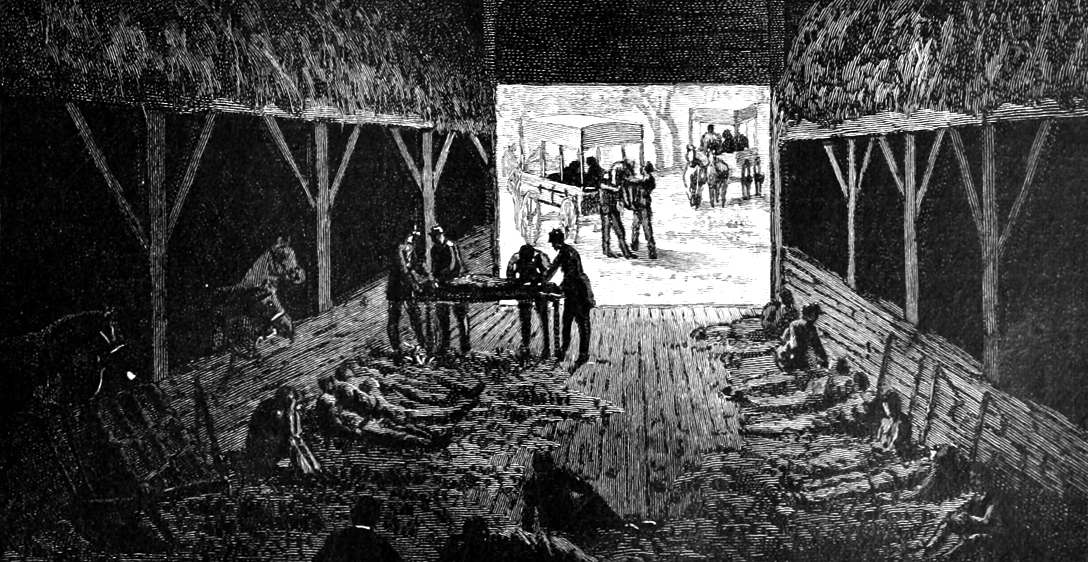
Written by Heidi Baumstark
War. Invasion. The enemy. That’s what’s been said about the worldwide Coronavirus (COVID-19) pandemic. News media consistently refers to it as the “invisible enemy,” a “global war” and “the plague.”
The troops? It’s the medical community and first responders united as one force, heroes on the front lines. Similarities can be drawn between today’s medics battling COVID-19 with doctors and nurses fighting diseases and injuries during the 19th century—specifically during the 1861-1865 Civil War. Just like then, today, make-shift field hospitals have popped up to serve the sick, and local communities have rallied.
Tracy Gillespie is the Site Manager for NOVA Parks sites including Mt. Zion Historic Park (site of the restored Mt. Zion Old School Baptist Church), Gilbert’s Corner Regional Park, Aldie Mill, Mt. Defiance Historic Park, and Goose Creek Bridge. During the Civil War, Gillespie said churches became hospitals, including Aldie’s Mt. Zion Church on current day Route 50, but during Civil War days, it was known as Little River Turnpike, from Aldie Mill, east. (West of the mill, Route 50 was known as Ashby’s Gap Turnpike, now John Mosby Highway.) Union troops used the church after the 1863 cavalry battles of Aldie (June 17), Middleburg (June 19), and Upperville (June 21); graffiti on the church’s walls prove evidence of soldiers’ days spent there in recuperation.
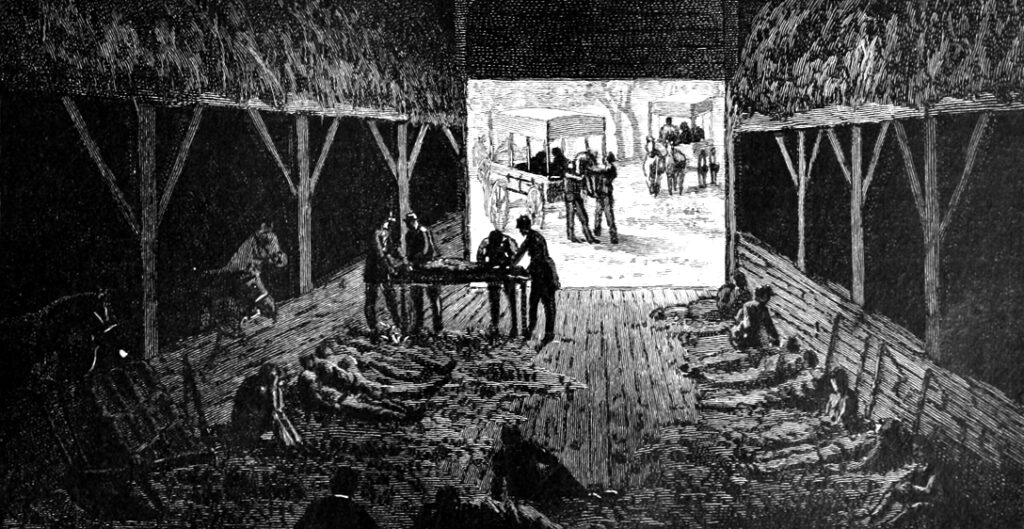
Field Hospitals were often located in barns near a battlefield. Courtesy photo of the Library of Congress
The barn of a nearby neighbor, Alexander and Eliza Davis—whose farm was on the current Gilbert’s Corner Regional Park property on Route 50—was used as a hospital and dead soldiers were buried behind the barn. Alexander is known as “Yankee Davis” for his efforts guiding Union troops in the area. In February 1865, Eliza wrote a letter to her mother-in-law who lived in Yankee territory, Connecticut, and describes the sites she witnessed. Portions of Eliza’s letter reads: ”… you can only know war by reason I have lived on the battle field for the last four years have seen the dead & dying all around me the wounded brought in numbers to die on with amputated limbs to recover crippled for life just as an all Wise Providence should see fit[.] Our barn on one side and the [nearby Mt. Zion] church on the other have as hospitals … been full of wounded dead and dying at the same time. An army of men encamped about on every side in every direction as far as the eye could see … One that died in the barn said when he was dying, ‘Oh, my poor wife and child.’ I don’t know who he was or where his wife and child are, but his body is buried in a grave with two others, just back of our barn, all three buried without coffins …”
On Sunday, July 21, 1861, Washingtonians came out to the rolling fields of Manassas to witness the Union army whip the Confederates in what they thought would be a one-day quick victory, arriving with picnic baskets in-hand. Instead, they witnessed the first major land battle of the Civil War that day, known as the First Battle of Manassas (or First Battle of Bull Run), a win for the Confederates. History of wars, as they knew it then, was entirely “romantic” and “dramatic.” They had a skewed view of what to expect, explained Richard Gillespie, Public Historian and Historian Emeritus for the Mosby Heritage Area Association (MHAA) and Volunteer Guide at NOVA Parks (and husband to Tracy Gillespie).
Jim Burgess, Museum Specialist at Manassas National Battlefield Park, pointed out that Brig. Gen. Thomas J. Jackson (Stonewall Jackson) should have had nearly 5,000 men in his brigade at First Manassas, but most sources indicate Jackson only had 2,500 men on Henry Hill that day. “How did all those troops disappear? Most of his losses can be attributed to sickness and disease well before any of his troops saw combat,” according to Burgess.
About a mile south from the Manassas battlefield was Ben Lomond, an 1832-built house that was used as a Confederate hospital. Because it thunder-stormed the night of First Manassas, the house would have been packed with suffering soldiers, but with a lack of medical supplies and limited medical staff. First Manassas resulted in about 3,500 casualties and the area wasn’t prepared. So, homes, barns, churches, and fields turned into make-shift hospitals.
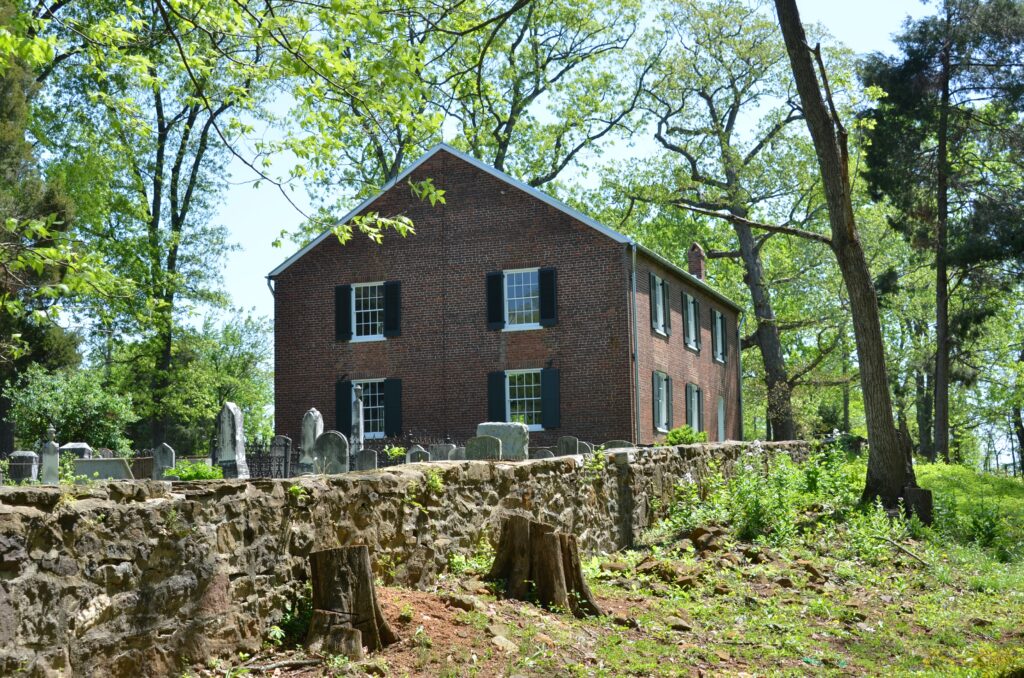
Mt. Zion Church at Mt. Zion Historic Park in Aldie, used as a Union hospital in June 1863 after three cavalry battles: Aldie (June 17), Middleburg (June 19), and Upperville (June 21). Courtesy photo by Tracy Gillespie
After First Manassas, Confederates eventually evacuated most of their wounded from local field hospitals, like Ben Lomond and St. Paul’s Church in Haymarket, to general hospitals set up in Warrenton, Culpeper, Gordonsville, Charlottesville, and Richmond. Confederate troops remaining in Northern Virginia continued to be plagued by disease, Burgess noted.
The next year brought Second Manassas, a three-day battle Aug. 28-30, 1862 back on the same Manassas fields, and another victory for the Confederacy. Richard Gillespie said that after Second Manassas, Middleburg, which was less than 20 miles west, became a major hospital town. Houses, churches, barns, and fields turned into hospitals with some 1,800 patients in town, which had a population of only 600. “These were mostly southern casualties; the ratio of soldiers dying from disease versus battle wounds was about two to one,” Gillespie said.
“Total mayhem” is how it can be described in late August through early September 1862. After Second Manassas and the Battle of Chantilly (Sept. 1, 1862 in Fairfax County) over 3,000 wounded Union soldiers were brought from these battlefields to the 1852-built train depot in Fairfax Station to wait for rail service to hospitals in Alexandria and Washington, D.C. Clara Barton, who later founded the American Red Cross in 1881, entered the war scene helping to transport soldiers by rail. In 1862, she became known as the “Angel of the Battlefield.”
Jake Wynn, Director of Interpretation at National Museum of Civil War Medicine in Frederick, Md., said the main battles in the Manassas area (First and Second Manassas and Battle of Balls Bluff, Oct. 21, 1861 in Leesburg) were Confederate victories. Farmhouses, barns, churches, businesses were used as hospitals. “About ninety-five percent of surgeries were done under chloroform or ether, used as anesthetics by both Union and Confederates. The Union side had preexisting labs manufacturing anesthetics, but Confederates built about eight labs of their own during the war. “These labs were created at key junctions; the closest one was in Richmond. They didn’t want one too close to D.C., so they didn’t build one near Manassas,” Wynn said. “The pharmaceutical industry gets jumpstarted during this time.”
Wynn said people thought the war would be quick. He added, “They didn’t have a frame of reference; there wasn’t a playbook, which is similar to today’s COVID-19 pandemic. There had never been something like this. The Revolution was fought decades earlier and anyone who lived through that was already gone. And the Civil War was between your ‘own people.’ There was a naïve mindset.”
The concept of hospitals derived directly from the war; before, doctors came to homes. Another outcome: the ambulance system. Wynn said, “We’re still using many of the ideas that originated out of the war, things like triage. They didn’t call it that back then, but decisions had to be made regarding who gets immediate care. They set up field hospitals like they’ve [been] doing in New York’s Central Park for COVID-19 patients. We can trace those things back to the Civil War.”
Lee Lawrence, of Lincoln in Loudoun County, is the editor and transcriber of “Dark Days in Our Beloved Country,” the Civil War diary of Catherine Barbara Hopkins Broun (1820-1903). Broun describes conditions during and after the war near her home called Sunny Bank on the southeast end of Middleburg on current-day Sam Fred Road. Lawrence has also researched Catherine Mary Powell Noland Cochran’s Diary and Memoir of the Civil War. Cochran (1814-1895) was the great granddaughter of Revolutionary War figure and Middleburg founder, Lt. Col. Leven Powell (1737-1810) and she was born and raised at Glen Ora outside of Middleburg, later, the country retreat of the Kennedys.
Lawrence said the diaries include terms like “camp fevers,” cholera, measles, typhoid. Soldiers were cared for in camps; doctors came to the home where people often died. The culture they lived in was so different. They were intimately acquainted with death; it happened all around them in their homes. Lawrence added, “Back then, illnesses like typhoid, cholera, septicemia, gangrene, dysentery killed so many because there were no antibiotics or penicillin—like today’s missing cure for COVID-19. Like those diseases in the 19th century, we are at the mercy of this current virus with no known cure.”
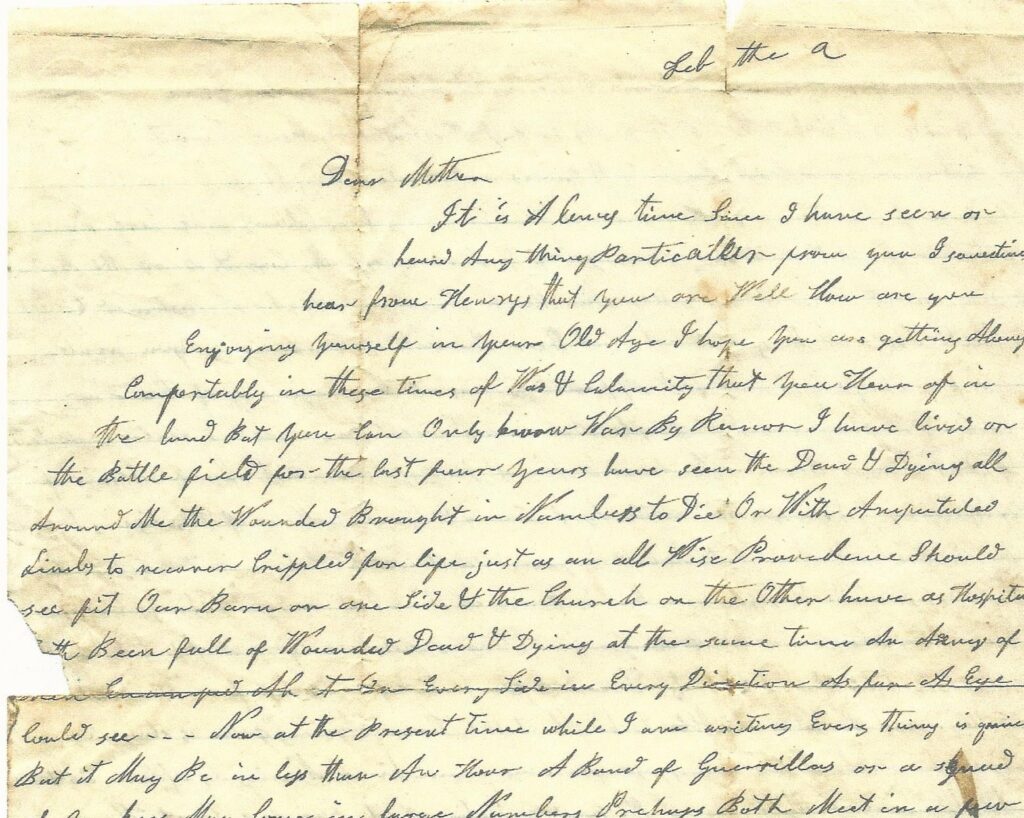
Cropped version of Eliza Davis’s letter from February 1865; she lived near what today is Gilbert’s Corner in Aldie. Courtesy photo from Tracy Gillespie
Broun’s diary includes entries about Union and Confederate armies occupying their town, their farm, even their parlor. A June 3, 1861 (one month before First Manassas) entry reads: “These are dark days in our beloved country. All business is suspended.” On July 23, 1861 (two days after First Manassas), Broun writes: “We witnessed today to an awful scene, the burial of those young men. Their mothers could not see them. They embraced their coffins in the cemetery. So much more awful than if they had died a natural death. … They say the sight is awful to behold. So many numberless, lying dead, the carriages cannot pass over the turnpike, for the dead. … And in one pile there were 1500 counted by Mr. L. Noland [reference is likely to Colonel Lloyd Noland of Glen Ora Farm outside Middleburg].”
In early September 1862 after Second Manassas, Broun writes: “The horrors of war are upon us. Middleburg is full of the wounded. In all the churches and vacant houses and laying about in the streets. Our new elegant church [referring to new Methodist Church on Washington Street built 1859] is crowded with the most pitiable objects that anyone could possibly conceive of. The stench is terrible. One died yesterday. The inhabitants are doing all they can, but it is but a drop in the bucket.” Lawrence spoke about Middleburg’s Historic Asbury Church built in 1829 at 105 N. Jay Street, which was Middleburg’s original Methodist church and was used as a Civil War hospital for Confederates; it is the oldest standing church in town.
Upon returning home after caring for wounded soldiers, Broun writes of having to “take off her clothes and shake out the lice.” But she doesn’t complain; instead just wonders, ‘How those men can stand them I cannot tell.’” Wounds from battle often turned into diseases like typhoid, blood loss, gangrene after amputations, pneumonia. In fact, Lawrence added, “Pneumonia is what killed Stonewall Jackson May 10, 1863 after his [left] arm was amputated on May 3 after the Battle of Chancellorsville.” He was mistakenly shot the night of May 2 by his own men. His physician, Dr. Hunter McGuire, amputated his arm at a field hospital. “If the battle didn’t kill you outright, disease would get you,” Lawrence said.
Now a look at Cochran’s diary. Comments about the latter part of the war include the state of the economy and government. She writes: “1864 opens dark and dreary—supplies diminishing and prices daily rising, Congress floundering hopelessly, aimlessly, nothing but talk and such mighty issues at stake. The nation looking anxiously to them for some action … finding them spending precious time in long discussions of frivolous points …”
Cochran’s diary paints a picture of local Fauquier and Loudoun sites: “On the 7th of this month [Sept. 7, 1864], we left Richmond for Loudoun. … The country being clear of Yankees, we took the old Warrenton road, passing the ruins of the once famous Warrenton Springs which the Yankees burnt in the campaign of ’62—a melancholy picture of desolation. The whole country, from the Rapidan to Loudoun has a desolate, forsaken look—fences all gone, houses burnt, dismantled or unoccupied. Villages of log huts, the remains of Yankee occupation remain standing tho hundreds, round Culpeper, have been hauled off for firewood.”
Near the end of the war, a Nov. 5, 1864 entry reads: “Well, we hear that the Yankees have really left The Plains and are moving down the road. It has been a severe scourge to the country, having them so long, and we doubtless shall hear many tales of hardship from those who have been within their lines all the time.”
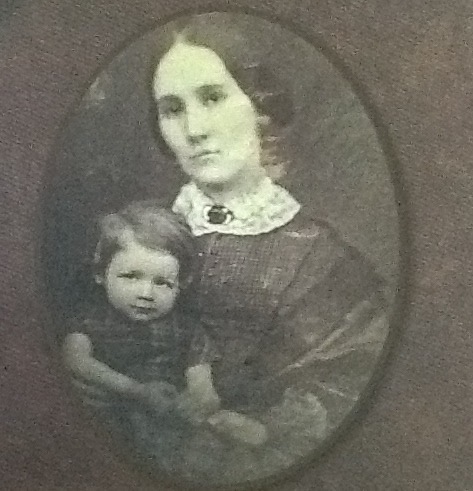
Catherine Barbara Hopkins Broun (1820-1903) of Middleburg with her son, Eddie Lee, born March 7, 1854. Courtesy photo from Lee Lawrence
A final story is a reminder of the war’s devastating emotional toll. John Chapman owned Chapman Mill (known today as Chapman-Beverley Mill) in Broad Run at Thoroughfare Gap along the Prince William-Fauquier line. His family built the mill in 1742, and over the years, the Chapmans prospered, enabling them to raise the mill to seven stories tall, believed to be the nation’s tallest stacked-stone building. Confederates used the mill as a meat curing center and distribution warehouse, and on Aug. 28, 1862, the Battle of Thoroughfare Gap unfolded in and around the mill.
Broken by the maltreatment by Union soldiers, the destruction of his property, and the certain knowledge that he had lost the mill, Chapman’s business never recovered, and he suffered a mental breakdown. His family said he became a lunatic in 1862, and in 1864, committed him to the Western Lunatic Asylum in Staunton, Va. Two years later he died in Dec.1866.
Wynn said, “What we’re facing now with COVID-19 is a national/global crisis. We can see how people faced issues back then and learn from them today.” Lawrence said, “It’s important to keep the stories in front of people.” ML
This article first appeared in the May 2020 issue of Middleburg Life.


